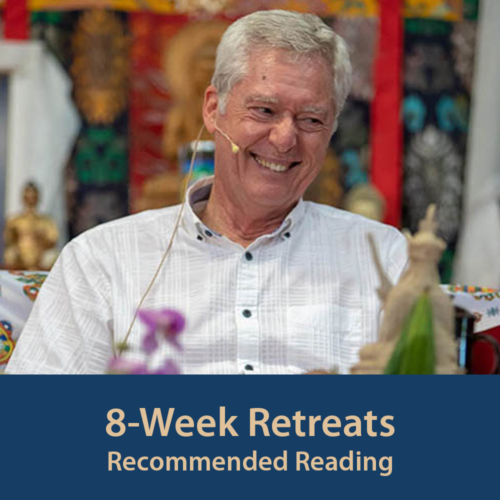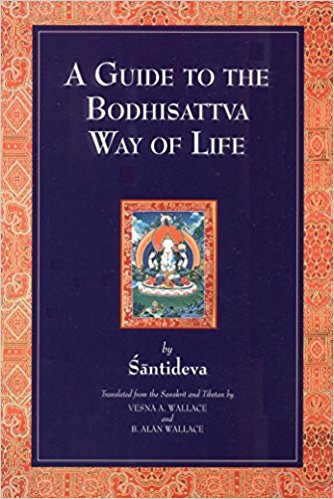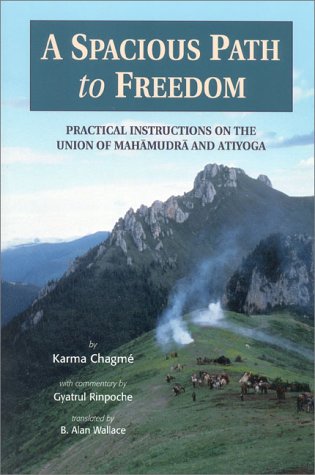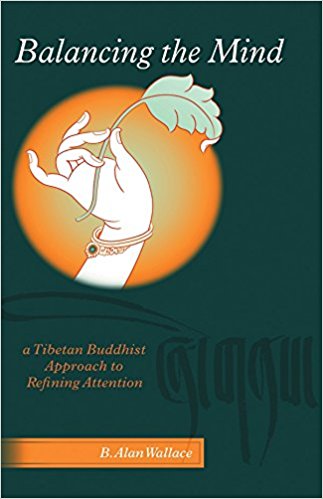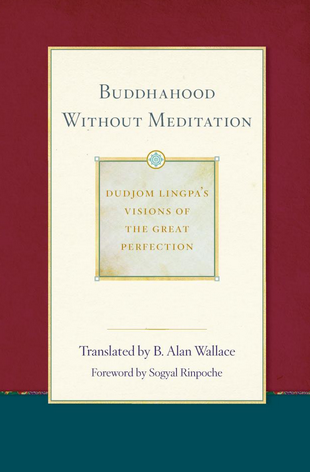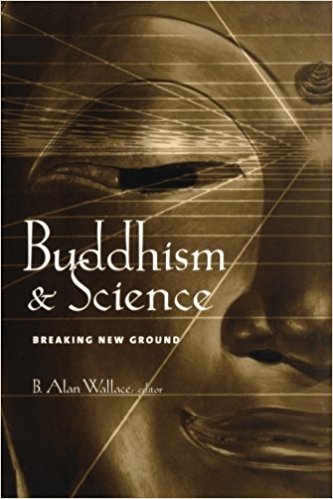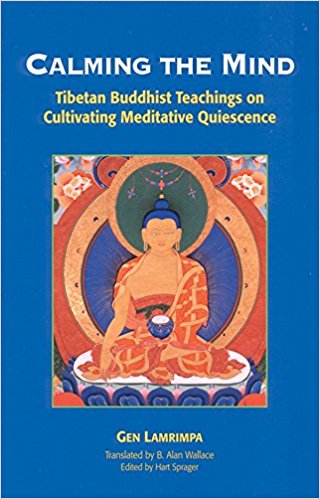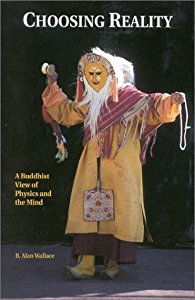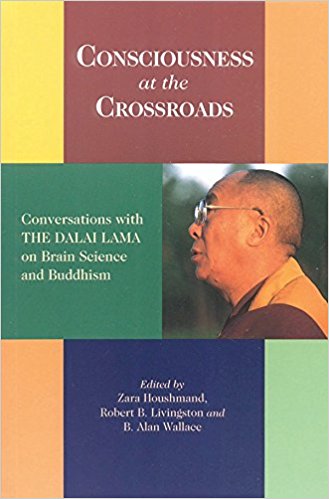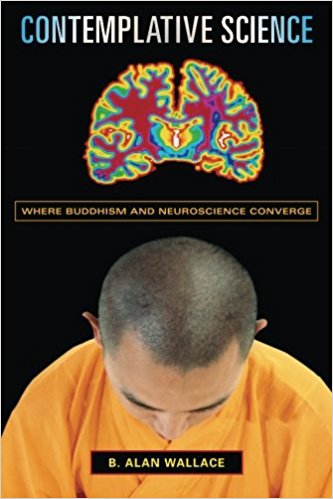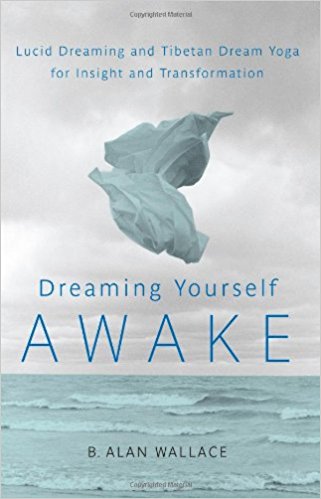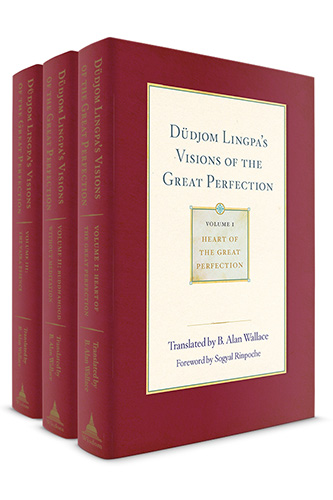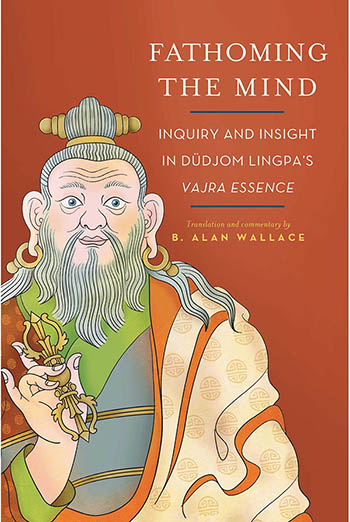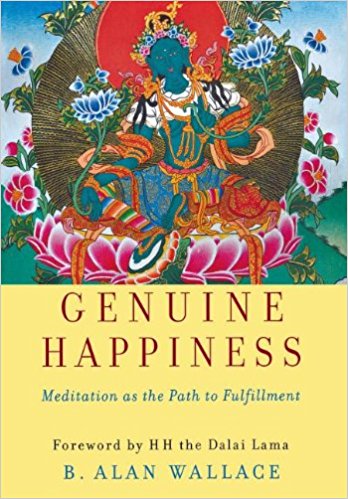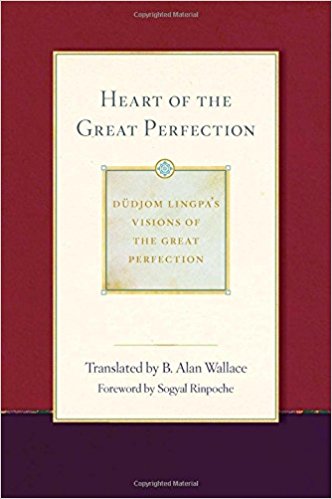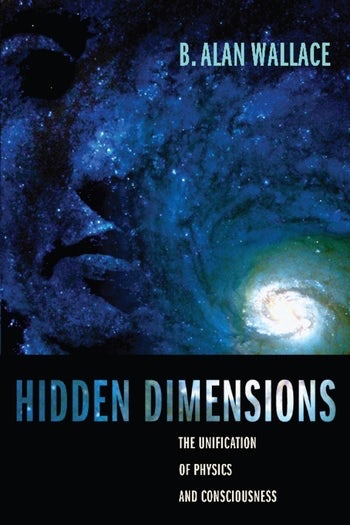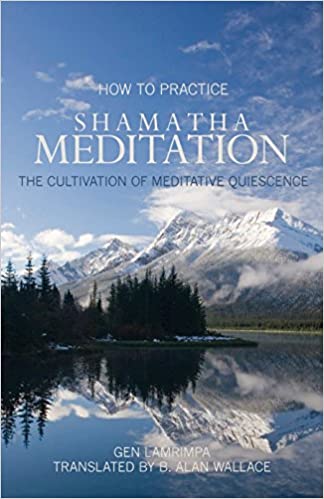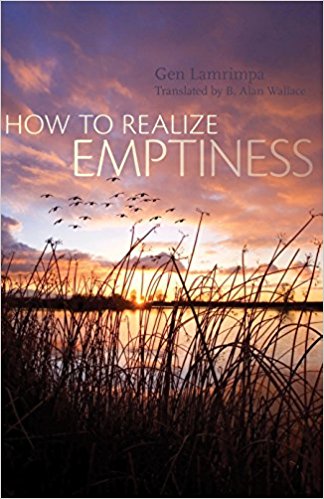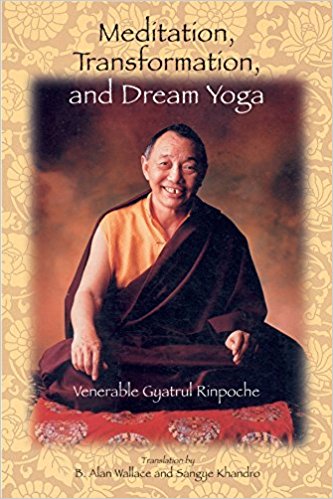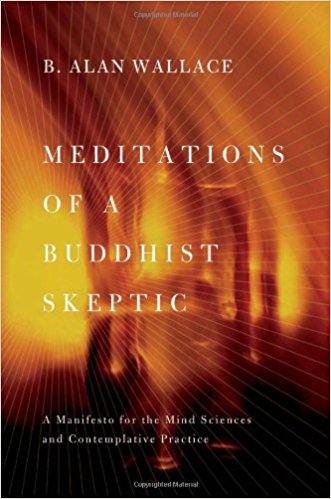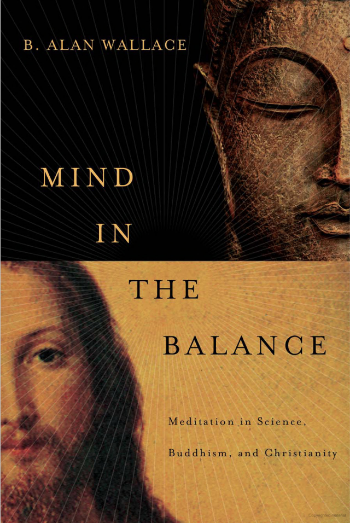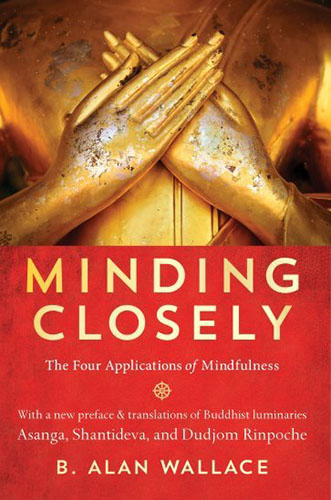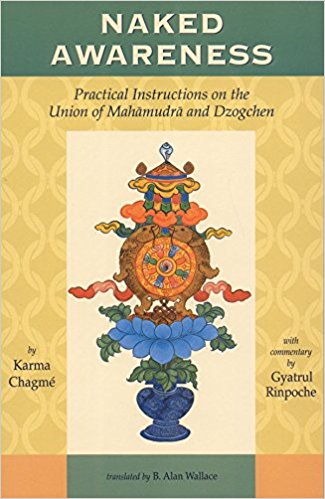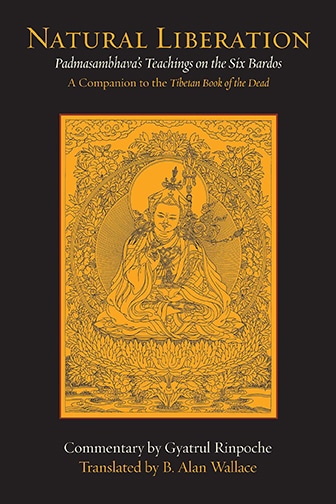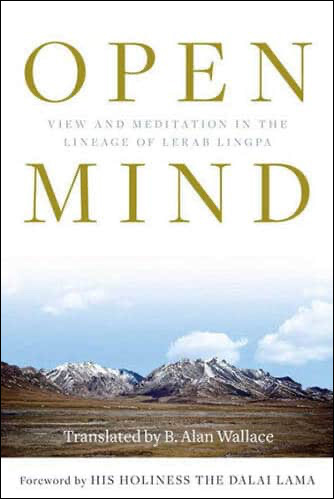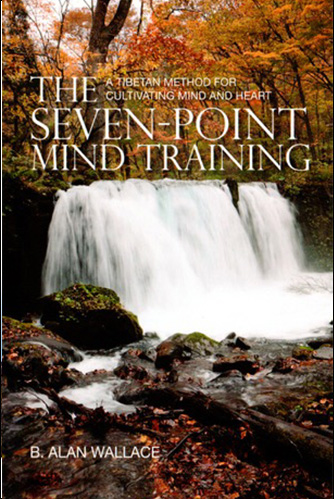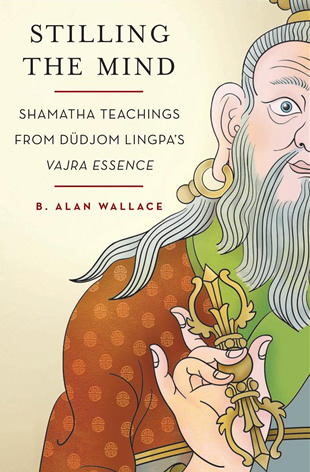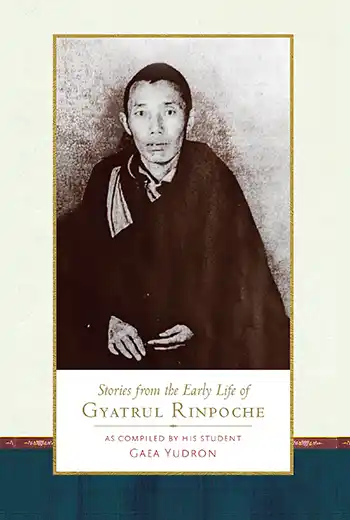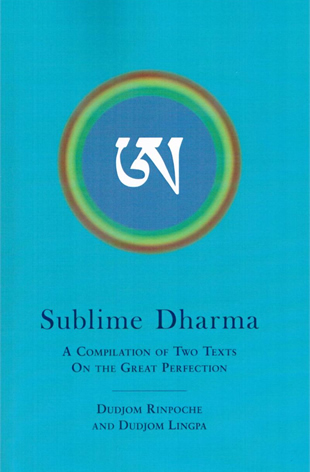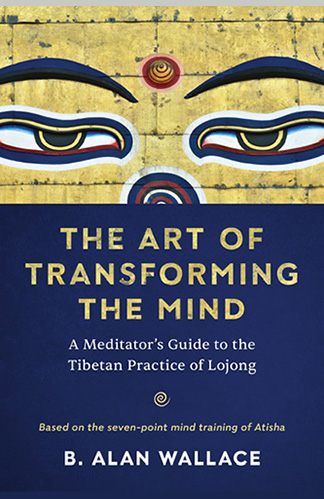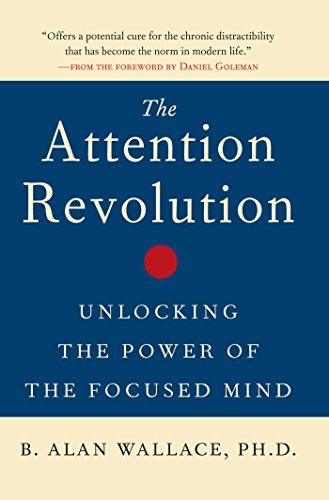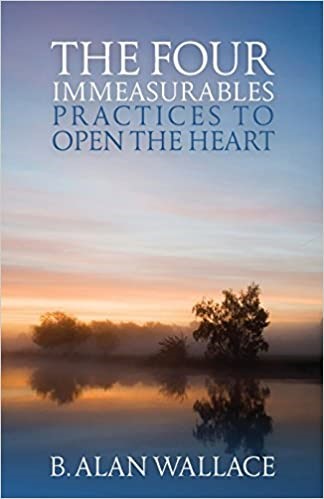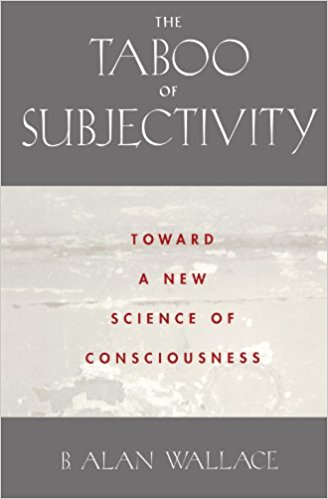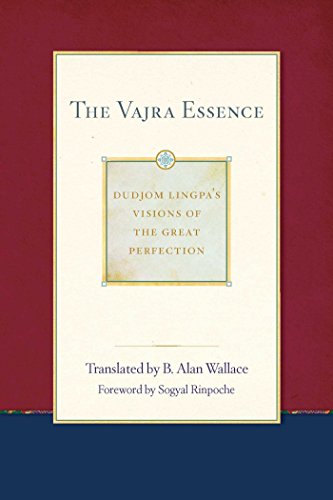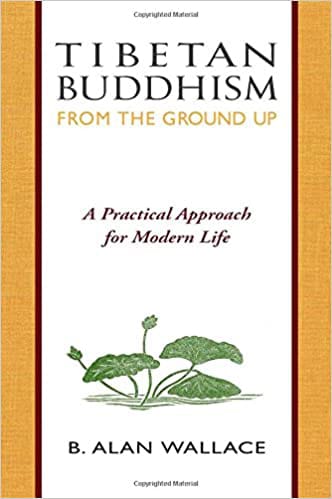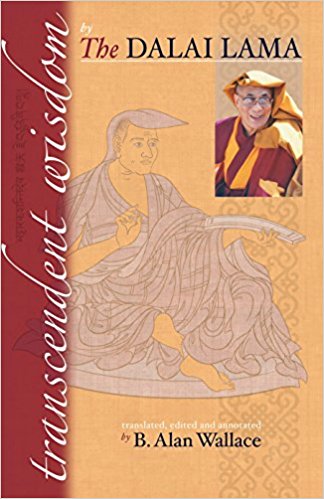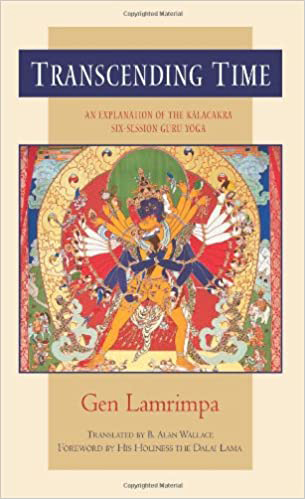Books
-
In the whole of the Tibetan Buddhist tradition there is no single treatise more deeply revered or widely practiced than A Guide to the Bodhisattva Way of Life. Composed in the eighth century by the Indian Bodhisattva Santideva, it became an instant classic in the curricula of the Buddhist monastic universities of India, and its renown has grown ever since. Santideva presents methods to harmonize one's life with the Bodhisattva ideal and inspires the reader to cultivate the perfections of the Bodhisattva--generosity, ethics, patience, zeal, meditative concentration and wisdom.
-
A Spacious Path to Freedom: Practical Instructions on the Union of Mahamudra and Atiyoga Karma Chagme sets forth the stages of meditation practice including the cultivation of meditative quiescence and insight, the experiential identification of awareness, and the highest steps of Mahamudra and Atiyoga leading to perfect enlightenment. Drawing from his enormous textual erudition and mastery of Tibetan oral traditions, he shows how these two meditative systems can be unified into a single, integrated approach to realizing the ultimate nature of consciousness. Karma Chagme was a major lineage-holder of the Karma Kagyu tradition of Tibetan Buddhism, and his writings are central to the Payul Nyingma order, making him an ideal figure to integrate two of the great meditation systems of Tibet: Mahamudra and Atiyoga.
-
Balancing The Mind: A Tibetan Buddhist Approach To Refining Attention For centuries Tibetan Buddhist contemplatives have directly explored consciousness through carefully honed rigorous techniques of meditation. B. Alan Wallace explains the methods and experiences of those Tibetan practitioners and compares these with investigations of consciousness by Western scientists and philosophers. Balancing the Mind includes a translation of a classic discussion by the fifteenth-century Tibetan contemplative Tsongkhapa of methods for developing exceptionally high degrees of attentional stability and clarity.
-
The second in a three-volume set presents the revelations of Düdjom Lingpa, a highly influential mystic of 19th century Tibet translated by B. Alan Wallace.
-
Buddhism and Science bring together distinguished philosophers, Buddhist scholars, physicists, and cognitive scientists to examine the contrast and connections between the worlds of Western science and Eastern spirituality. This compilation was inspired by a suggestion made by His Holiness the Dalai Lama, himself one of the contributors, after one of a series of cross-cultural scientific dialogues in Dharamsala, India, sponsored by the Mind and Life Institute.
-
Buddhism with an Attitude: The Tibetan Seven-Point Mind Training All of us have attitudes. Some of them accord with reality and serve us well throughout the course of our lives. Others are out of alignment with reality and cause us problems. Tibetan Buddhist practice isn't just sitting in silent meditation. It's developing fresh attitudes that align our minds with reality. Attitudes need adjusting, just like a spinal column that has been knocked out of alignment.
-
In 1998, Gen Lamrimpa, a Tibetan monk and contemplative, led a one-year retreat in the Pacific Northwest, during which a group of Western meditators devoted themselves to the practice of meditative quiescence (shamatha). This book is a record of the oral teachings he gave to this group at the outset of the retreat. The teachings are brought to life by Gen Lamrimpa's warmth, humor, and extensive personal experience as a contemplative recluse. An invaluable, practical guide for those seeking to develop greater attentional stability and clarity, this work will be of considerable interest to meditators, psychologists, and all others who are concerned with the potentials of the human mind.
-
For centuries scientists and philosophers have pondered the relationship between scientific theory and reality. Some have argued the "realist" position that science presents our best approximation of the natural world as it exists independently of human language and concepts. Others have long countered that humanity has no way of fathoming any reality independently of our modes of observation and conceptual frameworks. In their "instrumentalist" view, scientific theories simply make empirical evidence intelligible, without corresponding to any independent reality.
-
Consciousness at the Crossroads: Conversations with the Dalai Lama on Brain Science and Buddhism This book addresses some of the most fundamental and troublesome questions that have driven a wedge between the realms of Western science and religion for centuries. Consciousness at the crossroads is the result of a series of meetings between the Dalai Lama and a group of eminent neuroscientists and psychiatrists. The Dalai Lama regularly dedicates several days out of his busy schedule to engage in these kinds of meetings, which have resulted in more than a decade of fruitful dialogue between Buddhism and Western science.
-
SpecialScience has long treated religion as a set of personal beliefs that have little to do with a rational understanding of the mind and the universe. However, B. Alan Wallace, a respected Buddhist scholar, proposes that the contemplative methodologies of Buddhism and of Western science are capable of being integrated into a single discipline: contemplative science. The science of consciousness introduces first-person methods of investigating the mind through Buddhist contemplative techniques, such as samatha, an organized, detailed system of training the attention. Just as scientists make observations and conduct experiments with the aid of technology, contemplatives have long tested their own theories with the help of highly developed meditative skills of observation and experimentation. Contemplative science allows for a deeper knowledge of mental phenomena, including a wide range of states of consciousness, and its emphasis on strict mental discipline counteracts the effects of conative (intention and desire), attentional, cognitive, and affective imbalances. Available in hard or soft cover
-
Dreaming Yourself Awake: Lucid Dreaming and Tibetan Dream Yoga for Insight and Transformation by B. Alan Wallace and edited by Brian Hodel Some of the greatest of life’s adventures can happen while you’re sound asleep. That’s the promise of lucid dreaming, which is the ability to alter your own dream reality any way you like simply by being aware of the fact that you’re dreaming while you’re in the midst of a dream. There is a range of techniques anyone can learn to become a lucid dreamer—and this book provides all the instruction you need to get started. But B. Alan Wallace also shows how to take the experience of lucid dreaming beyond entertainment to use it to heighten creativity, to solve problems, and to increase self-knowledge. He then goes a step further: moving on to the methods of Tibetan Buddhist dream yoga for using your lucid dreams to attain the most profound kind of insight.
-
Düdjom Lingpa (1835–1904) was one of the foremost tantric masters of nineteenth-century Tibet. This new series includes Düdjom Lingpa’s five visionary teachings on the Great Perfection (Dzogchen), the pinnacle of practice in Tibet’s oldest Buddhist school, along with three essential commentaries. The teachings in this series have inspired generations of Tibetans. Translated by B. Alan Wallace This limited-edition set includes elegant clothbound editions of all three volumes, beautifully presented in a slipcase. This beautiful box set is out of stock, and temporarily out of print. A new edition is in the works but will not be available for a few years. You can still purchase a paperback edition of each volume, please see below for links to each.
-
Embracing Mind: The Common Ground of Science and Spirituality Both science and spirituality search for “ultimate truths.” God, the Big Bang, nirvana, the theory of evolution, relativity, quantum mechanics—these are some of the concepts that have been articulated as a result of that search. But the human capacity for exploring these ultimate sources of truth—the one thing that unites science and spirituality—is often overlooked. Embracing Mind argues (1) that science has hobbled itself by ignoring its unique source of inspiration—the mind—and (2) that the schism between science and spirituality is unnecessary. In language accessible to any intelligent reader, Embracing Mind first explores the veracity of major scientific “myths,” then presents a viable science of the mind emanating from contemplative spirituality, including Hindu, Christian, Sufi, and Buddhist views Please select either Hard cover or Soft cover version of the book
-
Fathoming the Mind “I am happy to bask in the glory of Düdjom Lingpa’s extraordinary Vajra Essence and am deeply grateful to Alan Wallace for bringing that brilliant and remarkable dialogue to a wider English-speaking audience. May all who touch and read this treasure benefit, and may its truth and power liberate all beings.”—from the foreword by DZONGSAR KHYENTSE RINPOCHÉ
-
Genuine Happiness: Meditation as the Path to Fulfillment In our search for happiness, we need not look far. True happiness is not found through the conquest of nature or the acquisition of wealth and fame -- it is found within by realizing the potential of our own hearts and minds. In Genuine Happiness, Alan Wallace, scholar and longtime Buddhist practitioner, helps you embrace the joy within through the unique power of meditation. Based on his thirty-four years of study and practice under the guidance of sixty teachers from the East and West, Alan Wallace describes a range of Tibetan meditation techniques from the simplest mindfulness of breathing to the exalted methods of Dzogchen.
-
Heart of the Great Perfection: Düdjom Lingpa’s Visions of the Great Perfection The first in a three-volume set presents the revelations of Düdjom Lingpa, a highly influential mystic of 19th century Tibet translated by B. Alan Wallace. This book is devoted to the Dzogchen vision of Düdjom Lingpa, contains four of his classic works explaining the view and practice of meditaiton. The Sharp Vajra of Conscious Awareness Tantra: This work is considered the root distillation of Düdjom Lingpa's wisdom. Essence of Clear Meaning: This definitive commentary, which unpacks the quintessential verses of The Sharp Vajra, is based on Düdjom Lingpa's oral teachings recorded by his disciple Pema Tashi. The Foolish Dharma of an Idiot Clothed in Mud and Feathers: Düdjom Lingpa narrates the essential Dharma teachings from the perspective of an old man rejecting superficial appearances. The Enlightened View of Samantabhadra: A masterful exposition of the Great Perfection is revealed as a dialogue between wisdom beings who bestow a treasury of pith instructions and specific advice for practitioners.
-
SpecialHidden Dimensions: The Unification of Physics and Consciousness Bridging the gap between the world of science and the realm of the spiritual, B. Alan Wallace introduces a natural theory of human consciousness that has its roots in contemporary physics and Buddhism. Wallace's "special theory of ontological relativity" suggests that mental phenomena are conditioned by the brain, but do not emerge from it. Rather, the entire natural world of mind and matter, subjects and objects, arises from a unitary dimension of reality that is more fundamental than these dualities, as proposed by Wolfgang Pauli and Carl Jung. Available in hard cover or soft cover
-
How to Practice Shamatha Meditation: The Cultivation of Meditative Quiescence
by Gen Lamrimpa, translated by B. Alan Wallace In 1988, Gen Lamrimpa, a Tibetan monk, led a one-year retreat in the Pacific Northwest, during which a group of Western meditators devoted themselves to the practice of meditative quiescence (shamatha). This book is a record of the oral teachings he gave to this group at the outset of the retreat. The teachings are brought to life by Gen Lamrimpa's warmth, humor, and extensive personal experience as a contemplative recluse. An invaluable practical guide for those seeking to develop greater attentional stability and clarity, this work will be of considerable interest to meditators, psychologists, and all others who are concerned with the potentials of the human mind. -
In How to Realize Emptiness, Gen Lamrimpa draws on his theoretical training as well as his solitary meditative experience to show how students can gain realization of ultimate reality. He explains in a practical and down-to-earth fashion how to analyze experience to fathom how it has been misperceived and misunderstood because of our many delusions, and how to use Madhyamaka reasoning to experience the way in which all things exist as dependently related events. Those who with to apply the Madhyamaka view to meditative practice and daily life will undoubtedly find this work to be of great practical value. The book closes with two chapters on Dzogchen and its relation to Madhyamaka.
-
The three traditional Nyingma texts included in this book were selected by Ven. Gyatrul Rinpoche for their relevance to the modern-day spiritual aspirant who must combine and balance quality practice time, work time and rest time in the course of a busy day.
-
Meditations of a Buddhist Skeptic: A Manifesto for the Mind Sciences and Contemplative Practice Renowned Buddhist philosopher B. Alan Wallace reasserts the power of shamatha and vipashyana, traditional Buddhist meditations, to clarify the mind's role in the natural world. Raising profound questions about human nature, free will, and experience versus dogma, Wallace challenges the claim that consciousness is nothing more than an emergent property of the brain with little relation to universal events. Rather, he maintains that the observer is essential to measuring quantum systems and that mental phenomena (however conceived) influence brain function and behavior. Wallace embarks on a two-part mission: to restore human nature and to transcend it. He begins by explaining the value of skepticism in Buddhism and science and the difficulty of merging their experiential methods of inquiry. Yet Wallace also proves that Buddhist views on human nature and the possibility of free will liberate us from the metaphysical constraints of scientific materialism. He then explores the radical empiricism inspired by William James and applies it to Indian Buddhist philosophy’s four schools and the Great Perfection school of Tibetan Buddhism. Read the first chapter of the book- See pdf. file attached
-
By establishing a dialogue in which the meditative practices of Buddhism and Christianity speak to the theories of modern philosophy and science, B. Alan Wallace reveals the theoretical similarities underlying these disparate disciplines and their unified approach to making sense of the objective world. Wallace begins by exploring the relationship between Christian and Buddhist meditative practices. He outlines a sequence of meditations the reader can undertake, showing that, though Buddhism and Christianity differ in their belief systems, their methods of cognitive inquiry provide similar insight into the nature and origins of consciousness. Mind In The Balance - Available in soft or hard cover
-
MINDING CLOSELY: The Four Applications of Mindfulness Second Edition This edition includes a new preface and never-before-published translations by B. Alan Wallace of three renowned Buddhist works on mindfulness by Asanga, Shantideva, and Dudjom Rinpoche. The ability to sustain close mindfulness is a learned skill that offers profound benefits in all situations. This book explains the theory and applications of the practice the Buddha called the direct path to enlightenment. These simple but powerful techniques to cultivate mindfulness will allow anyone, regardless of tradition, beliefs, or lack thereof, to achieve genuine happiness and freedom from suffering. By closely minding the body and breath, we relax, grounding ourselves in physical presence. Coming face to face with our feelings, we stabilize our awareness against habitual reactions. Examining mental phenomena nakedly, we sharpen our perceptions without becoming attached. Ultimately, we see all phenomena just as they are, and we approach the ground of enlightenment.
-
In this classic 17th-century presentation of the union of Mahamudra and Dzogchen, Karma Chagme, one of the great teachers of both these lineages of Tibetan Buddhism, begins with an overview of the spirit of awakening and the nature of actions and their ethical consequences. Next, drawing from his enormous erudition and profound experience, Karma Chagme gives exceptionally lucid instructions on the two phases of Dzogchen practice--the "Breakthrough" and the "Leap-over"--followed by an accessible introduction to the practice of the transference of consciousness at the time of death.
-
Natural Liberation: Padmasambhava's Teachings on the Six Bardos In the spirit of the Buddhist tantric tradition, Natural Liberation is concerned primarily with how to take the commonplace states of consciousness experienced in life and death and turn them into opportunities for the highest liberation. In this work, Padmasambhava, the great eighth-century Indian master who established Buddhism in Tibet, describes in detail six life-processes, or bardos, and how to transform them into vehicles for enlightenment. This most extraordinary teaching is here accompanied by meditation instructions and edifying anecdotes in a lucid commentary by Gyatrul Rinpoche, an esteemed teacher of the Nyingma tradition.
-
Open Mind: View and Meditation in the Lineage of Lerab Lingpa, translated by B. Alan Wallace and featuring a foreword by His Holiness the Dalai Lama. Lerab Lingpa was one of the great Dzogchen masters of the nineteenth and early-twentieth centuries and a close confidant and guru of the Thirteenth Dalai Lama. Open Mind contains translations of two works that are representative of the lineage of this great “treasure revealer,” or tertön. This volume will be of great interest for all those interested in the theory and practice of the Great Perfection and the way it relates to the wisdom teachings of Tsongkhapa and others in the new translation schools of Tibetan Buddhism.
-
In this society with its hurly-burly pace demanding of our time, it is ever so easy to let life slip by. The process of simply existing is not necessarily meaningful. And yet, there is an unlimited potential for meaning and value in this human existence. The Seven-Point Mind Training is one eminently practical way of tapping into that meaning.
-
In The Attention Revolution, bestselling author Alan Wallace guided readers through the stages of shamatha, a meditation for focusing the mind. Here he uses the wisdom of the Dzogchen—the highest of all the Tibetan meditation traditions—to open up this practice into a space of freedom from hope and fear by introducing us to one of the most cherished works of the Nyingma school of Tibetan Buddhism, Düdjom Lingpa’s Vajra Essence.
-
Venerable Gyatrul Rinpoche was Lama Alan's primary Dzogchen Lama since the 1990's. Venerable Gyatrul Rinpoche is an esteemed Buddhist master and among the great spiritual mentors of our time. Stories from the Early Life of Gyatrul Rinpoche is filled with tales of his early years: from his birth in 1925, up to the time he left for the West in 1972, where he traveled from one world to another—leaving the lands of Tibet and India and entering the speedy, modern Western world, becoming a pioneer in establishing Vajrayana Buddhism. If you have never met Gyatrul Rinpoche, these stories will provide an excellent introduction. And if you have been Rinpoche’s student or friend for many years, your appreciation for his stainless qualities and everything he has lived through and accomplished to bring dharma into this world may very well deepen. We are currently out of stock but we are accepting orders. We hope to receive additional copies and to be able to ship your order by June 25, 2023. We have already sold out of our first order but more will be on the way soon. Thank you for your understanding. You can read more below.
-
Sublime Dharma: Quintessential Instructions on the Breakthrough and Direct Crossing-Over Stages of Dzogchen is a compilation of two works composed by two of the greatest Dzogchen masters of Tibetan Buddhism in recent history, Dudjom Lingpa (1835-1904) and his subsequent incarnation, Dudjom Rinpoche (1904-1987).
-
The Art of Transforming the Mind
A Meditator's Guide to the Tibetan Practice of Lojong
Tibetan Buddhist practice isn't just sitting in silent meditation, it's developing fresh attitudes that align our minds with reality. Includes three new translations of Atisha’s source material including Pith Instructions on a Single Mindfulness and Pith Instructions on the Middle Way.
In this book, B. Alan Wallace explains a fundamental type of mental training that is designed to shift our attitudes so that our minds become pure wellsprings of joy instead of murky pools of problems, anxieties, fleeting pleasures, hopes, and frustrations. The lojong—or mind-training—teachings have been the subject of profound study, contemplation, and commentary by many great masters. B. Alan Wallace shows us the way to develop our capacity for spiritual awareness through his relatable and practical commentary on the mind-training slogans.
This is an updated version of Buddhism With An Attitude
-
The Attention Revolution: Unlocking the Power of the Focused Mind Meditation offers, in addition to its many other benefits, a method for achieving previously inconceivable levels of concentration. Author B. Alan Wallace has nearly thirty years' of practice in attention-enhancing meditation, including a retreat he performed under the guidance of the Dalai Lama. An active participant in the much-publicized dialogues between Buddhists and Scientists, Alan is uniquely qualified to speak intelligently to both camps, and The Attention Revolution is the definitive presentation of his knowledge.
-
This book is a rich suite of practices that open the heart, counter the distortions in our relationships to ourselves, and deepen our relationships to others. Alan Wallace presents a unique interweaving of teachings on the Four Immeasurables (the cultivation of loving-kindness, compassion, equanimity, and empathetic joy) with instruction on quiescence or shamatha meditation practices to empower the mind and render it "fit for service." The book includes both guided meditation and lively discussions on the implications of these teachings for our own lives.
-
This book takes a bold new look at ways of exploring the nature, origins, and potentials of consciousness within the context of science and religion. Alan Wallace draws careful distinctions between four elements of the scientific tradition: science itself, scientific realism, scientific materialism, and scientism. Arguing that the metaphysical doctrine of scientific materialsm has taken on the role of ersatz-religion for its adherents, he traces its development from its Greek and Judeo-Christian orgins, focusing on the interrelation between the Protestant Reformation and the Scientific Revolution.
-
Düdjom Lingpa (1835–1904) was one of the foremost tantric masters of nineteenth-century Tibet, and his powerful voice resonates strongly among Buddhist practitioners today. The Vajra Essence is Düdjom Lingpa’s most extended meditation on the path of Great Perfection, in many senses a commentary on all his other Dzogchen works. This is the first translation of this seminal work in any Western language, and B. Alan Wallace, with his forty-five-plus years of extensive learning and deep meditative experience, is one of the most accomplished translators of Tibetan texts into English.Translated by B. Alan Wallace.
-
"One of the most readable, accessible, and comprehensive introductions to Tibetan Buddhism... This book is 'user-friendly.'" - Mandala Asking neither unquestioning faith nor blind obedience to abstract concepts or religious beliefs, this highly readable book challenges us to question and investigate life's issues for ourselves in the light of an ancient and effective approach to the sufferings and joys of the human condition.
-
TRANSCENDENT WISDOM by H.H. the Dalai Lama, translated, edited and annotated by B. Alan Wallace This extraordinarily clear exposition on the wisdom section of the Guide to the Bodhisattva's Way of Life is based on an oral teaching given in Switzerland by HH the Dalai Lama before an audience of thousands of Tibetans and Westerners in 1979.
-
Transcending Time: An Explanation of the Kalachakra Six-Session Guruyoga Inspired by years of scholarly training and decades of solitary retreat, Tibetan monk Gen Lamrimpa offers a concise overview of all phases of the Kalachakra practice: the preliminaries, the initiation, and finally, the stages of generation and completion. With remarkable clarity, he makes the Six-Session Guruyoga practice accessible to all practitioners, and deepens our understanding and appreciation of this sublime teaching of the Buddha.


